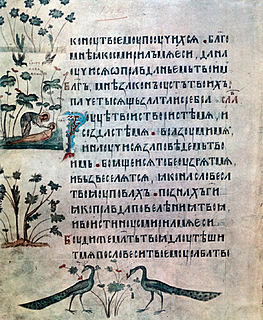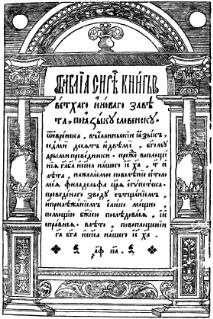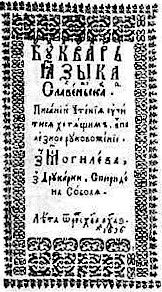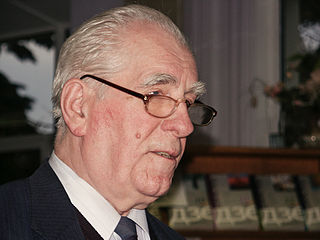
The Cyrillic script is a writing system used for various languages across Eurasia and is used as the national script in various Slavic, Turkic, Mongolic and Iranic-speaking countries in Southeastern Europe, Eastern Europe, the Caucasus, Central Asia, North Asia and East Asia.

Cyril and Methodius (815–885) were two brothers and Byzantine Christian theologians and missionaries. For their work evangelizing the Slavs, they are known as the "Apostles to the Slavs".

Belarusians, also and Byelorussians, are an East Slavic ethnic group who are native to modern-day Belarus and the immediate region. There are over 9.5 million people who proclaim Belarusian ethnicity worldwide, with the majority residing either in Belarus or the adjacent countries where they are an autochthonous minority.

Old Church Slavonic or Old Slavonic was the first Slavic literary language.

Belarusian is an East Slavic language spoken by the Belarusians. It is one of the two official languages in the Republic of Belarus under the current Constitution, along with Russian. Additionally, it is spoken in some parts of Russia, Lithuania, Latvia, Poland, and Ukraine by Belarusian minorities in those countries.

Polotsk is a historical city in Belarus, situated on the Dvina River. It is the center of the Polotsk District in Vitsebsk Voblast. Its population is more than 80,000 people. It is served by Polotsk Airport and during the Cold War was home to Borovitsy air base.
Ruthenian or Old Ruthenian was the group of varieties of East Slavic spoken in the Grand Duchy of Lithuania and later in the East Slavic territories of the Polish–Lithuanian Commonwealth. The written form is also called Chancery Slavonic by Lithuanian and Western European linguists.

Francysk Skaryna was a Ruthenian humanist, physician, and translator. He is known to be one of the first book printers in the Grand Duchy of Lithuania and in all of Eastern Europe, laying the groundwork for the development of the Belarusian izvod of the Church Slavonic language.

Church Slavonic, also known as Church Slavic, New Church Slavonic or New Church Slavic, is the conservative Slavic liturgical language used by the Orthodox Church in Bulgaria, Russia, Belarus, Serbia, Montenegro, Bosnia and Herzegovina, North Macedonia, Ukraine, Poland, the Czech Republic and Slovakia, Slovenia and Croatia. The language appears also in the services of the Russian Orthodox Church Outside of Russia, the American Carpatho-Russian Orthodox Diocese and occasionally in the services of the Orthodox Church in America.

Ivan Fyodorov was one of the fathers of Eastern Slavonic printing, he was the first known Russian printer in Moscow and the Polish–Lithuanian Commonwealth, he was also a skilled cannon maker and the inventor of a multibarreled mortar.
The Ukrainian alphabet is the set of letters used to write Ukrainian, the official language of Ukraine. It is one of the national variations of the Cyrillic script. The modern Ukrainian alphabet consists of 33 letters.
The culture of Belarus is the product of a millennium of development under the impact of a number of diverse factors. These include the physical environment; the ethnographic background of Belarusians ; the paganism of the early settlers and their hosts; Eastern Orthodox Christianity as a link to the Byzantine literary and cultural traditions; the country's lack of natural borders; the flow of rivers toward both the Black Sea and the Baltic Sea; and the variety of religions in the region.

The Ostrog Bible was one of the earliest East Slavic translations of the Bible and the first complete printed edition of the Bible in Church Slavonic, published in Ostroh, in the Polish–Lithuanian Commonwealth, by the printer Ivan Fyodorov in 1581 with the assistance of the Ruthenian Prince Konstantin Ostrogski.

Szymon Budny or Symon Budny was a Polish-Belarusian humanist, educator, Hebraist, Bible translator, Protestant reformer, philosopher, sociologist and historian, active in the territory of the Polish–Lithuanian Commonwealth. He was one of the first to promote the development of Belarusian culture in the Belarusian language. He was one of the leaders of the Polish Brethren.

Yefim Fyodorovich Karskiy was a Belarusian-Russian linguist-Slavist, ethnographer and paleographer, founder of Belarusian linguistics, literary studies and paleography, a member of numerous scientific institutions, and author of more than 100 works on linguistics, ethnography, paleography and others.
Belarusian literature is the writing produced, both prose and poetry, by speakers of the Belarusian language.

Spiridon Sobol was a Belarusian printer and educator. Sobol was the first East Slavic printer to use copper etching. His name is associated with the printing house in Kuciejna, near Orsha, which he founded in 1630.

The tradition of Bible translations in Christianity in Russia begins with Slavic translations of the Bible and Old Church Slavonic.
The history of all Bible translations into Slavic languages begins with Bible translations into Church Slavonic. Other languages include:

Nil Hilevich was a Belarusian poet, a professor in the Belarusian State University, the author of more than 80 books of poetry, publications, and translations, and one of the founders of the Francišak Skaryna Belarusian Language Society.















